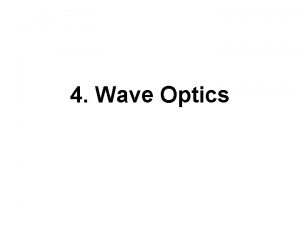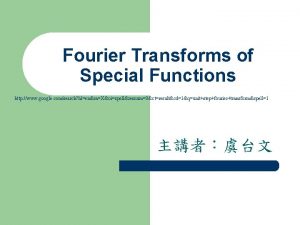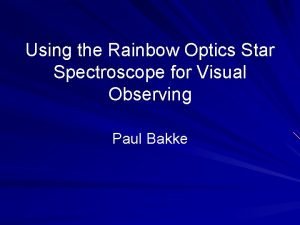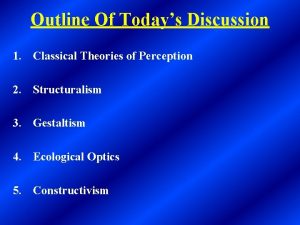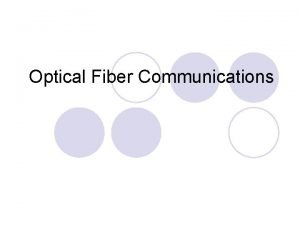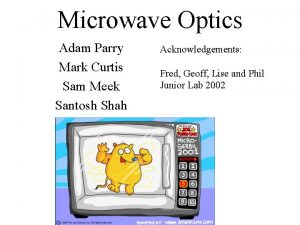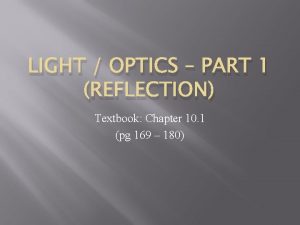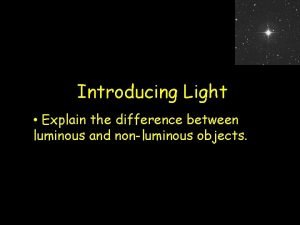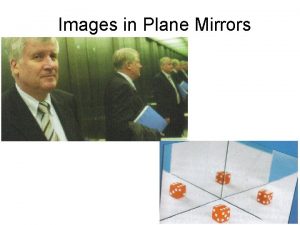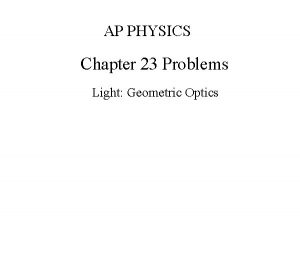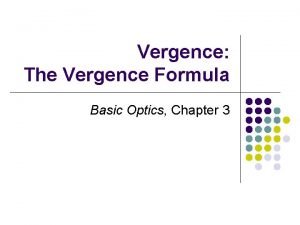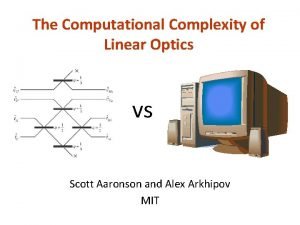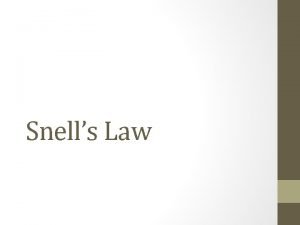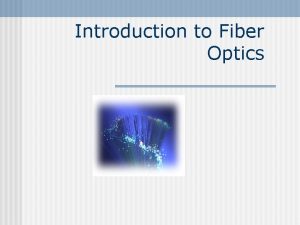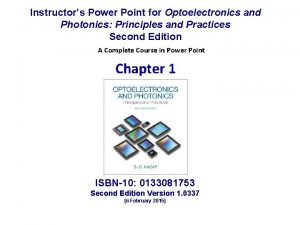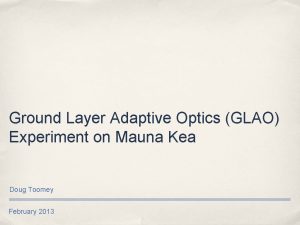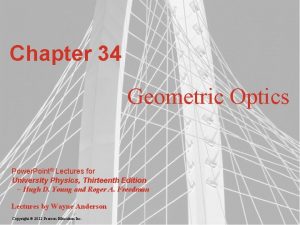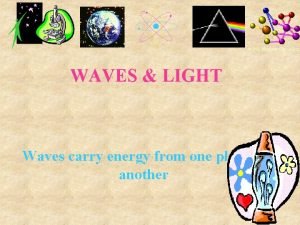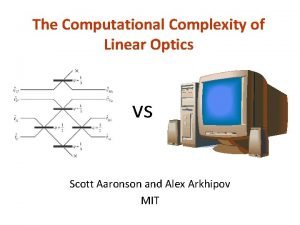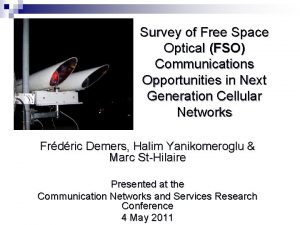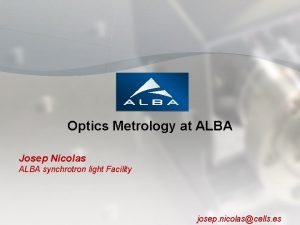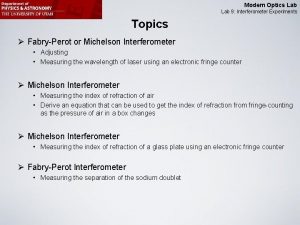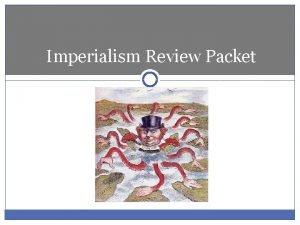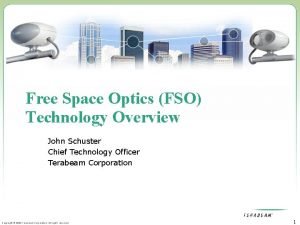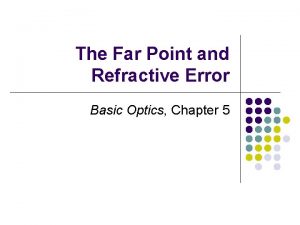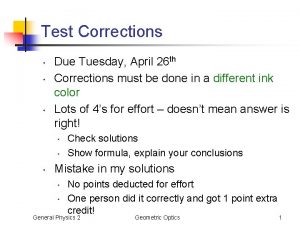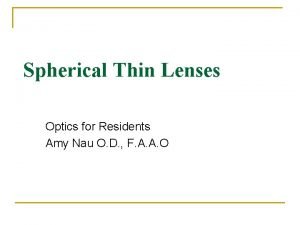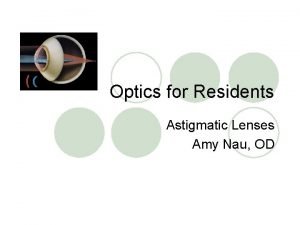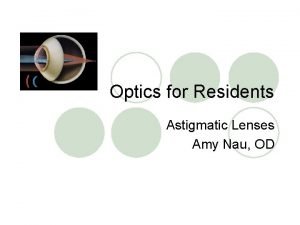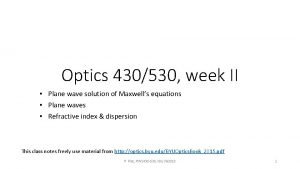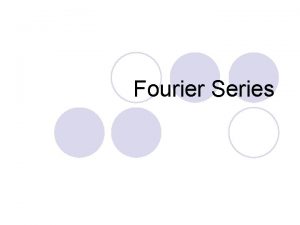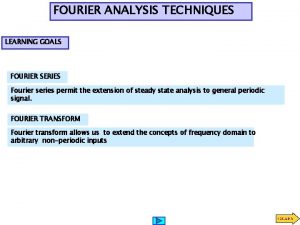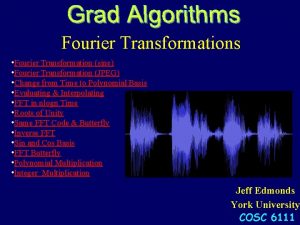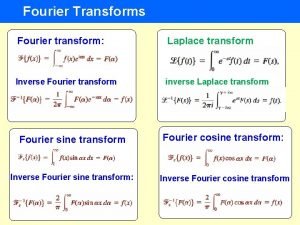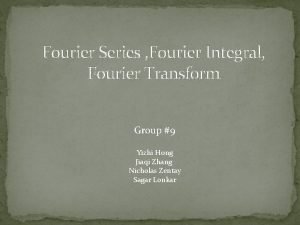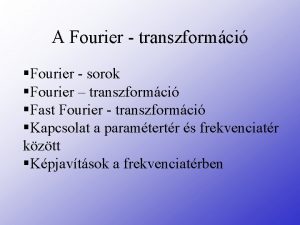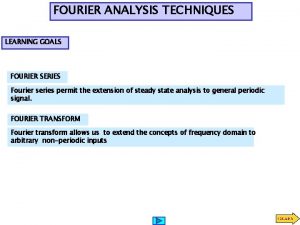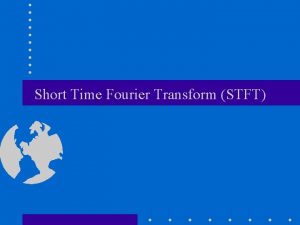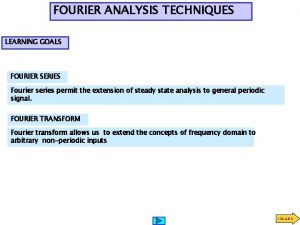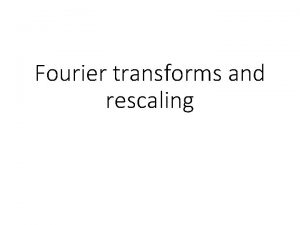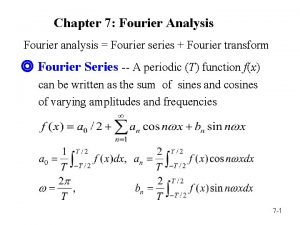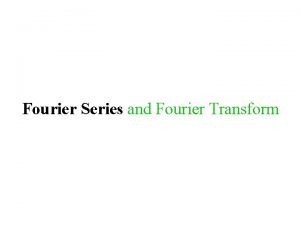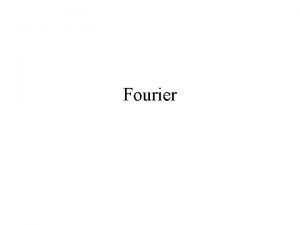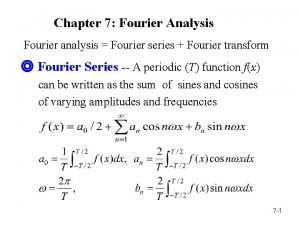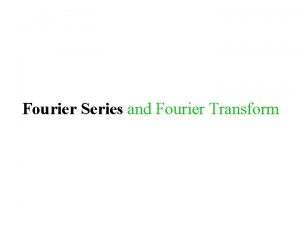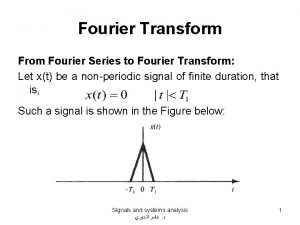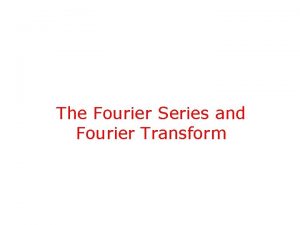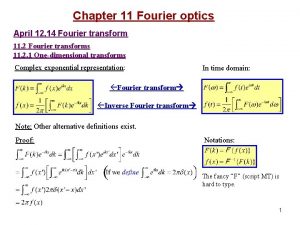FOURIER OPTICS P 47 Optics Unit 8 UNIT









































- Slides: 41

FOURIER OPTICS P 47 – Optics: Unit 8

UNIT 8 Course Outline Unit 1: Electromagnetic Waves Unit 2: Interaction with Matter Unit 3: Geometric Optics Unit 4: Superposition of Waves Unit 5: Polarization Unit 6: Interference Unit 7: Diffraction Unit 8: Fourier Optics Unit 9: Modern Optics

UNIT 8 Fourier Optics: The Basic Idea Peatross & Ware

UNIT 8 Array Theorem Calculate the diffraction pattern caused by N identical apertures with Change of variables:

UNIT 8 Array Theorem in the Real World: Discrete Fourier Transform of 2 D Images For a list of N sample data points (1 D) For an Mx. N array of sample data points (2 D) A lot of work has been put into algorithms to calculate this as efficiently as possible. (FFTW) www. originlab. com

UNIT 8 Fourier Optics Connection between the spatial frequency at a source, and the intensity in the far-field

UNIT 8 Spatial Frequency • Spatial information in images can be broken down into Fourier components, at high and low frequency • units of 1/length (e. g. cycles/mm)

UNIT 8 Spatial Frequency ky kx • Low spatial frequency information is at the center of the Fourier plane • high spatial frequency information is at the edges

UNIT 8 Fourier Filter Image Processing

UNIT 8 Fourier Filter Image Processing can filter out unwanted noise if it’s sufficiently distinct in spatial frequency from the signal of interest Block out spatial frequencies associated with the diagonal lines to recover most of the information in the original image These techniques are pretty important in medical imaging of all kinds

UNIT 8 Fourier Filter Image Processing

UNIT 8 Fourier Filter Image Processing

UNIT 8 Common Fourier Transforms

UNIT 8 Spatial Filtering of a Laser Removing high spatial frequency components from the Fourier/focal plane results in a smoother laser beam, without speckle and distortion Input beam Output beam

UNIT 8 Linear Systems

UNIT 8 Linear Systems

UNIT 8 Linear Systems • Aperture Function • Point Spread Function • Transfer Function These general ideas apply to a much wider variety of physical systems: e. g. linear electronic circuits

UNIT 8 What’s the Point? We need better tools than the Rayleigh resolution criterion for determining how faithfully our optical systems transmit information from source to image: Modulation Transfer Function

UNIT 8 Aperture (pupil) Function Bahtinov mask (geoastro. com)

UNIT 8 Point Spread Function imaging in the “real world” • What if we don’t have a point object? • The image formed by a real, finite imaging system is the convolution of the ideal image with the point spread function. Practically speaking, the ideal image gets blurred out in a very specific way determined by the point spread function

UNIT 8 Array Theorem Calculate the diffraction pattern caused by N identical apertures with Change of variables:

UNIT 8 Example: Annular Aperture It hurts the resolution a bit, but how much? Autocorrelation of an annular aperture: HW!

UNIT 8 Example: Annular Aperture a

UNIT 8 Example: PSF of Annular Aperture What is the Fourier transform of this function?

UNIT 8 Example: PSF of Annular Aperture To get the point spread function: What’s the point of this? This is the intensity pattern you’ll see from a point source:

UNIT 8 Example: PSF of Annular Aperture Note: Don’t leave out the cross terms! No central obstruction Notice the “wrong” solution is also obviously unphysical!

UNIT 8 Example: The Hubble PSF Calculation Single Wavelength

UNIT 8 Example: The Hubble PSF Calculation Point-source diffraction pattern There’s spatial frequency information hiding in plain sight here Hubble aperture model: • Secondary mirror obstruction • Radial supports for secondary • Three pads holding primary mirror

UNIT 8 Convolution, Correlation, and Autocorrelation The convolution of two one-dimensional functions is: The (cross) correlation of two functions is Note that if either function is even Correlation of a function with itself is called an autocorrelation

UNIT 8 Convolution https: //en. wikipedia. org/wiki/Convolution

UNIT 8 Convolution Examples

UNIT 8 Convolution Theorem (proof in notes) Why is this useful? To convolve two functions, Fourier transform them, multiply them together and then apply the inverse Fourier transform on their product! If you already know the Fourier (and inverse) transforms it makes calculating the convolution much easier!

UNIT 8 Convolution Theorem

UNIT 8 Example: Convolution of two Gaussians The convolution is still a Gaussian and the width is that of the original Gaussians summed in quadrature!

UNIT 8 Evaluating Fidelity of Optical Systems Remember this is a linear system: If we put in a signal at a specific spatial frequency, we can ask how well that information is reproduced at the output of the system (the final image) The Modulation Transfer Function (MTF) measures loss of contrast for sharp lines at different spatial frequencies Full contrast No contrast

UNIT 8 Calculating the Modulation Transfer Function MTF is simply the autocorrelation of the aperture function of the system! Aperture function: Rescale to spatial-frequency units: The autocorrelation of a rectangle is easy: it’s just a triangle… Note: The cutoff frequency above which no spatial information makes it through the system (diffraction limit!)

UNIT 8 Modulation Transfer Function (Square vs Circular Aperture) • The cutoff frequency is the same for square and circular apertures • BUT the frequency/wavelength dependence is different • (less light = less resolving power!) Low spatial frequencies make it through fine Higher spatial frequencies have less contrast, falling to zero at the cutoff The larger the aperture, the higher the cutoff frequency (more resolution)

UNIT 8 Measuring Modulation Transfer Function • MTF for real optical elements is normally measured • most common to simply image a target object of various spatial frequencies • takes aberrations into account

UNIT 8 Evaluating MTF and Resolution Are many different test patterns…

UNIT 8 Real-World Diffraction Limit Reality: Aperture usually isn’t the limiting factor, it’s aberrations (esp. atmospheric conditions) Subaru Telescope (D = 8 m) Hubble (D = 2. 4 m)

UNIT 8 Fourier Optics
 Difference between ray optics and wave optics
Difference between ray optics and wave optics Venn diagram of geometric optics and physical optics
Venn diagram of geometric optics and physical optics Fourier optics
Fourier optics Step function fourier transform
Step function fourier transform Rainbow optics star spectroscope
Rainbow optics star spectroscope Gestaltism
Gestaltism Turba optics
Turba optics Types of optics
Types of optics Sam meek
Sam meek First light optics
First light optics Grade 10 optics review
Grade 10 optics review Phys 241 purdue
Phys 241 purdue Whats a luminous object
Whats a luminous object Plane mirror characteristics
Plane mirror characteristics Hotwire salisbury nc
Hotwire salisbury nc Single slit envelope
Single slit envelope Optics topics
Optics topics Types of optics
Types of optics Optics
Optics Vergence formula
Vergence formula The computational complexity of linear optics
The computational complexity of linear optics Snell's law
Snell's law Bill nye reflection and refraction
Bill nye reflection and refraction Introduction to fiber optics
Introduction to fiber optics Cauchy formula optics
Cauchy formula optics Adaptive optics
Adaptive optics Geometrical
Geometrical Geometrical optics ppt
Geometrical optics ppt What medical procedure uses fiber optics bill nye
What medical procedure uses fiber optics bill nye The computational complexity of linear optics
The computational complexity of linear optics Free space optics
Free space optics Nicolas alba
Nicolas alba Modern optics experiment
Modern optics experiment Optics
Optics Free space optics
Free space optics Disadvantages of fibre optic cable
Disadvantages of fibre optic cable Far point of hyperopic eye
Far point of hyperopic eye Physics 2
Physics 2 Power of lens formula class 10
Power of lens formula class 10 Maddox rod
Maddox rod Interval of sturm
Interval of sturm Optics poynting's theorem
Optics poynting's theorem


